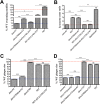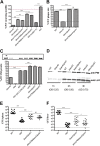A prl mutation in SecY suppresses secretion and virulence defects of Listeria monocytogenes secA2 mutants
- PMID: 25535272
- PMCID: PMC4325107
- DOI: 10.1128/JB.02284-14
A prl mutation in SecY suppresses secretion and virulence defects of Listeria monocytogenes secA2 mutants
Abstract
The bulk of bacterial protein secretion occurs through the conserved SecY translocation channel that is powered by SecA-dependent ATP hydrolysis. Many Gram-positive bacteria, including the human pathogen Listeria monocytogenes, possess an additional nonessential specialized ATPase, SecA2. SecA2-dependent secretion is required for normal cell morphology and virulence in L. monocytogenes; however, the mechanism of export via this pathway is poorly understood. L. monocytogenes secA2 mutants form rough colonies, have septation defects, are impaired for swarming motility, and form small plaques in tissue culture cells. In this study, 70 spontaneous mutants were isolated that restored swarming motility to L. monocytogenes secA2 mutants. Most of the mutants had smooth colony morphology and septated normally, but all were lysozyme sensitive. Five representative mutants were subjected to whole-genome sequencing. Four of the five had mutations in proteins encoded by the lmo2769 operon that conferred lysozyme sensitivity and increased swarming but did not rescue virulence defects. A point mutation in secY was identified that conferred smooth colony morphology to secA2 mutants, restored wild-type plaque formation, and increased virulence in mice. This secY mutation resembled a prl suppressor known to expand the repertoire of proteins secreted through the SecY translocation complex. Accordingly, the ΔsecA2prlA1 mutant showed wild-type secretion levels of P60, an established SecA2-dependent secreted autolysin. Although the prl mutation largely suppressed almost all of the measurable SecA2-dependent traits, the ΔsecA2prlA1 mutant was still less virulent in vivo than the wild-type strain, suggesting that SecA2 function was still required for pathogenesis.
Copyright © 2015, American Society for Microbiology. All Rights Reserved.
Figures





Similar articles
-
SecA2 is not required for secretion of the surface autolysin IspC in Listeria monocytogenes serotype 4b.J Basic Microbiol. 2014 Sep;54(9):1017-21. doi: 10.1002/jobm.201300007. Epub 2013 May 26. J Basic Microbiol. 2014. PMID: 23712923
-
Identification of a second Listeria secA gene associated with protein secretion and the rough phenotype.Mol Microbiol. 2002 Aug;45(4):1043-56. doi: 10.1046/j.1365-2958.2002.03072.x. Mol Microbiol. 2002. PMID: 12180923
-
SecA2-dependent secretion of autolytic enzymes promotes Listeria monocytogenes pathogenesis.Proc Natl Acad Sci U S A. 2003 Oct 14;100(21):12432-7. doi: 10.1073/pnas.2133653100. Epub 2003 Oct 3. Proc Natl Acad Sci U S A. 2003. PMID: 14527997 Free PMC article.
-
Emerging themes in SecA2-mediated protein export.Nat Rev Microbiol. 2012 Nov;10(11):779-89. doi: 10.1038/nrmicro2874. Epub 2012 Sep 24. Nat Rev Microbiol. 2012. PMID: 23000954 Free PMC article. Review.
-
The protein secretion systems in Listeria: inside out bacterial virulence.FEMS Microbiol Rev. 2006 Sep;30(5):774-805. doi: 10.1111/j.1574-6976.2006.00035.x. FEMS Microbiol Rev. 2006. PMID: 16911044 Review.
Cited by
-
Management of Listeria monocytogenes on Surfaces via Relative Air Humidity: Key Role of Cell Envelope.Foods. 2021 Aug 26;10(9):2002. doi: 10.3390/foods10092002. Foods. 2021. PMID: 34574112 Free PMC article.
-
A Redox-Responsive Transcription Factor Is Critical for Pathogenesis and Aerobic Growth of Listeria monocytogenes.Infect Immun. 2017 Apr 21;85(5):e00978-16. doi: 10.1128/IAI.00978-16. Print 2017 May. Infect Immun. 2017. PMID: 28193635 Free PMC article.
-
SpoVG Is a Conserved RNA-Binding Protein That Regulates Listeria monocytogenes Lysozyme Resistance, Virulence, and Swarming Motility.mBio. 2016 Apr 5;7(2):e00240. doi: 10.1128/mBio.00240-16. mBio. 2016. PMID: 27048798 Free PMC article.
-
Protein Export into and across the Atypical Diderm Cell Envelope of Mycobacteria.Microbiol Spectr. 2019 Jul;7(4):10.1128/microbiolspec.gpp3-0043-2018. doi: 10.1128/microbiolspec.GPP3-0043-2018. Microbiol Spectr. 2019. PMID: 31400094 Free PMC article. Review.
-
Structural Similarities and Differences between Two Functionally Distinct SecA Proteins, Mycobacterium tuberculosis SecA1 and SecA2.J Bacteriol. 2015 Dec 14;198(4):720-30. doi: 10.1128/JB.00696-15. J Bacteriol. 2015. PMID: 26668263 Free PMC article.
References
Publication types
MeSH terms
Substances
Grants and funding
LinkOut - more resources
Full Text Sources
Other Literature Sources
Medical

